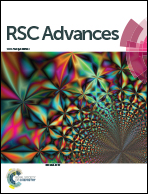Ultrafast excited state dynamics of [Cr(CO)4(bpy)]: revealing the relaxation between triplet charge-transfer states†
Abstract
Ultrafast excited state dynamics of [Cr(CO)4(bpy)] upon metal-to-ligand charge-transfer (1MLCT) transition have been studied by pump-probe absorption spectroscopy in CH3CN, pyridine and CH2Cl2 solvents. Intersystem crossing (ISC) was found to be very fast (∼100 fs) and efficient, while the formation of the photoproduct with one axial CO dissociated is significantly less competitive, indicating a barrier along the dissociative coordinate. As a refinement of the previous dynamic model [I. R. Farrell, et al., J. Am. Chem. Soc., 1999, 121, 5296−5301], we show that a conventional downhill energy relaxation concept dominates the observed dynamics. Experimentally, we have identified the consecutive population of two triplet states as a result of triplet electronic relaxation convoluted with vibrational and solvent relaxation (the overall time is 2.7–6.9 ps depending on solvent), as well as the overall depopulation of the excited state through the lowest triplet state (57–84 ps). Adaptive excitation pulse shaping could not achieve optimization of the photoproduct quantum yield via re-distribution of only low-frequency vibrational modes during excitation, indicating that the two low-lying 1MLCT states, Cr(3d) → π*bpy and Cr(3d) → π*CO, are not coupled.
![Graphical abstract: Ultrafast excited state dynamics of [Cr(CO)4(bpy)]: revealing the relaxation between triplet charge-transfer states](/en/Image/Get?imageInfo.ImageType=GA&imageInfo.ImageIdentifier.ManuscriptID=C5RA25670D&imageInfo.ImageIdentifier.Year=2016)

 Please wait while we load your content...
Please wait while we load your content...